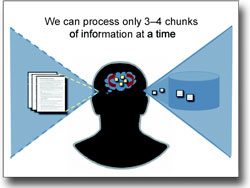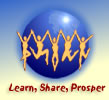Seven Ways to Use Information Design
to Create Remarkable User Experiences (Part 1)
by Adele Sommers
What's the "secret sauce" behind designing information that corrals the interest of your users, visitors, readers, learners, or customers and spurs them to take fast and effective action?
Answer: A timeless set of information-design guidelines that work synergistically, regardless of the medium you're using or the message you're conveying -- and whether you're a business writer, technical communicator, instructional designer, interface designer, Web developer, or multimedia content creator.

This series of articles will explain seven ways to engage and support your audiences whenever you want them to understand, learn, and do.
You might be creating Web pages, publications, online training, marketing content, or information-based multimedia productions, for example.
Why not move the needle from "lackluster and low-powered" to "remarkable and robust" with the very next project you start?
You'll see these seven tips rolled out over three articles, grouped into these three overarching themes:
A. Lay a Foundation for Clear Understanding
B. Help Your Audiences Do What They Really Need to Do
C. Add Novelty and Interactivity to Stir Emotion & Spur Action
Use the first set of tips below to begin designing remarkable user experiences!
A. Lay a Foundation for Clear Understanding

To lasso your viewers' attention and trigger their ability to comprehend, recall, and respond, you'll want to begin by:
- Learning more about your typical audience members
- Structuring information so your target audiences can readily consume it, and
- Minimizing the "data dump" effect that occurs when people receive too much information
These foundational principles underlie all types of communication, so they will powerfully support whatever you're creating. See the details below!
Tip #1: Use persona profiles to understand your audience -- what makes them tick?
Your audience comprises the people who will engage with your content. They represent a mix of backgrounds, skills, personality traits, and so forth. Some might be tech savvy; some might not. Some might be very familiar with your topic, others not. Some might be older, others younger. Some might think "pink," others "green."
So, you need a way to identify the people you're trying to attract, and then accommodate their needs accordingly. If you don't, they won't be able consume your content easily -- and probably won't urge their friends and colleagues to consume it, either!
Enter the persona, a fictitious but realistic character who symbolizes a typical member of your target audience. Your audience probably has several such people in it. Aim to create a persona profile for each representative audience member.

You could do this through interviewing, market research, or even imagining a composite based on people you know. That way, you'll discover what makes each type of audience member tick. You can then design an approach that addresses each persona's primary needs, wants, questions, and concerns.
But what if you're short on time or insights? Consider at least these two critical angles:
- What worries, problems, or challenges could be keeping each persona awake at night?
- What are each persona's likely goals, hopes, aspirations, and dreams?
Ponder what matters most on both ends of the spectrum for each persona. Then design the types of content and features that would best support each persona's needs -- without interfering with the others!
Action step - Learn more about persona profiles:
Tip #2: Structure information to help people scan, skip, and retrieve what matters
 As information creators, we need to "grab people by the eyeballs" and give them more control over what we are submitting for their attention. As information creators, we need to "grab people by the eyeballs" and give them more control over what we are submitting for their attention.
We must enable our audiences to scan, skip, and retrieve -- and then act on the information fast, before the relentless demands on their time force their attention to shift elsewhere!
An excellent approach to this "eyeball management" problem involves structured authoring (also known as structured writing). Five of its core methodologies appear below.
- Classifying of information organizes content into five actionable types: facts, concepts, processes, procedures, and principles. These are the building blocks for information design.
- Chunking breaks crowded or detailed content into smaller, more digestible messages.
- Simplifying uses very direct, "plain talk" to get ideas across fast. Avoid dense, convoluted "corporate-speak," "academic-speak," or a meandering style when you want people to act quickly!
- Arranging text and graphics with visual cues helps people scan, skip, and retrieve efficiently. Examples of visual cues include bulleted lists, tables, white space, headers, bolded text, labels, dividers, hierarchies, grouping, and relative size.
- Illustrating reinforces (or replaces) text with clear, relevant graphic elements.
Action step - Learn more about structured authoring:
Tip #3: Strive to minimize audience overload, especially in training and presentations
Another way to help people understand is by reducing what's known as "cognitive overload." Research published in the mid-1950s seemed to show that our short-term "working memories" can process about "7 plus or minus 2" chunks of input at a time. (Think of this as the number of items you could remember to buy at the supermarket, for example, without having to write them all down.)
 Nearly 50 years later, however, a new wave of research showed that in reality, we're capable of consuming only about 3 or 4 chunks of information at once. That's not very much processing power (and explains why we make so many lists)! Nearly 50 years later, however, a new wave of research showed that in reality, we're capable of consuming only about 3 or 4 chunks of information at once. That's not very much processing power (and explains why we make so many lists)!
But information design principles can come to the rescue by easing the burden on the viewer's brain. Working within the limitations of short-term memory reduces the information-processing load.
This means that the content we design must be "high-impact" to grab attention, but also "low-bandwidth" in terms of the effort and brain-power required to process it. The easier the information is to process, the more readily people will:
- Retain the information
- Retrieve it from memory under the right circumstances, and
- Apply it or act on it in the way you intended!
Action step - Learn more about cognitive overload:
In Conclusion...
With a little imagination, by regularly applying the three techniques above, you'll powerfully support your audience's ability to consume whatever you're producing. Stay tuned for Part 2!
Copyright 2012 Adele Sommers
|


